Those of us who go to Brooklands regularly are familiar with the museum site. Apart from the clubhouse and hangars, and the beautifully restored Campbell and Jackson Sheds, a huge amount of the original fabric of the place survives. The Members' Bridge and Test Hill are all still there, together with a sizeable chunk of the Members' Banking and a small section of the old Campbell Circuit. The majority of the old pre- Mercedes World museum site can be seen below:
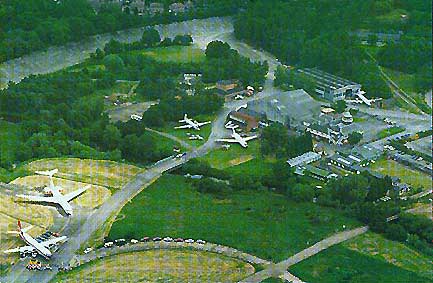
The Members' Banking and the end of the Finishing Straight,
with the Wellington Hangar on it can be seen at the top of the picture.
The large grey pitched roof in the centre is the home of the aero engines
and the stratosphere chamber. The clubhouse joins this building below right.
The Wey Navigation runs horizontally across the middle of the frame with
the main bridge just to the left of the two aircraft. The white dot above
it is the oldest airline ticket office in the world- a delightful tile
roofed structure about the size of a garden shed.
The two white lines in amongst the trees on the right
are the railings for the Test Hill, the top of which is marked by the grey
roofed building. All these areas are popular features,
restored and labelled as befits a proper historic site. However, given the size of the original Brooklands site, odd little bits survive here and there which have so far not been worked on by the museum.
On the main bridge over the Wey, which is the main access route to the runway from the museum area, there are holes cut in the steel sides with rollers at their edges, rather like those found on ships for passing ropes through. The speculation is that they are for fire hoses. The fire pumps would thus draw directly from the Wey. I have no idea when they were put in, although I would guess they would date from the time when large aircraft were using the runway.
Tunnels
Further round the track between
the Members' Bridge and the end fence by Gallaghers are some air raid shelters which look a little like brick 'pill boxes , and slightly more
like very low public lavatories! 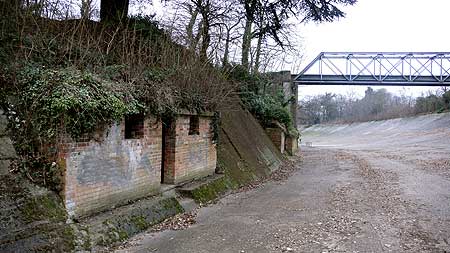 Beyond them are the original public
entry tunnels. There were three tunnels, one each for spectators
entering or leaving the track and a central one which was reversed morning
and afternoon depending on the prevailing direction. Currently (Jan 2009) there's quite a bit of aeroplane gubbins around, some of which is being stored in the tunnel.
Beyond them are the original public
entry tunnels. There were three tunnels, one each for spectators
entering or leaving the track and a central one which was reversed morning
and afternoon depending on the prevailing direction. Currently (Jan 2009) there's quite a bit of aeroplane gubbins around, some of which is being stored in the tunnel.
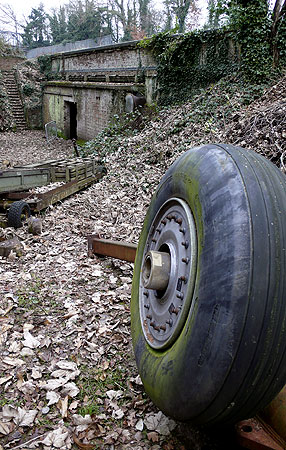
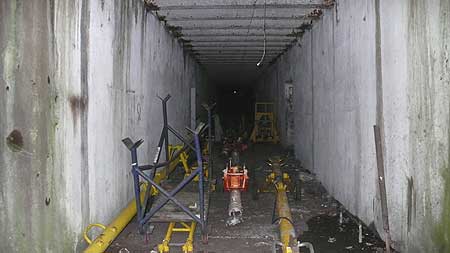
The centre tunnel is open and can
be inspected, although take a good torch and some friends as it is very
dark and quite scary down there! There are small openings to the two other
tunnels and a tiny grille in the bricked-up outer wall (the dot in the distance in the picture here) which now is the
foot of someone's garden.
The buried chassis
Another tunnel runs under the banking a few hundred yards further anticlockwise. This was the road access tunnel and for years was closed by a permanently locked set of doors. Now it has been cleaned up a lot and new lighting installed, possibly for reinstatement as a site entrance? The ground rises beside the roadway from the tunnel towards the acoustic chamber and Concorde. About ten feet up on this bank are the remains of a car chassis with engine block, embedded in the ground. What little is visible shows that it is pre war, possibly the remains of a racer which came to grief there? (It's been suggested it's a Ford special) It seems an odd place to dump junk, though it might have been used as hardcore for the concrete around the tunnel entrance. In the photo below you can see some piled up bits of pre-cast concrete from Vickers bearing the AV monogram.
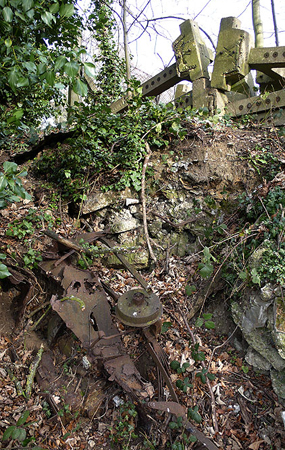
Note: Please don't be tempted to climb up to the chassis! - the ground here is full of brambles, hidden loose bits of concrete, sharp metal and all sorts of nasties. Best to leave well alone for others to enjoy, as it has been there for at least 60 years..
On top of the Test Hill
Climbing the Test Hill, most people make for the bridge directly opposite the top. This is a modern replacement of the original but replicates the girder design. Sadly it leads nowhere now, the pedestrian access path having been swallowed up by the suburban gardens behind and you're forced to retrace your steps. Rather than going back down the Test Hill however, have a look at the large shed at the top. This was originally a cafeteria, supplying the now long-gone grandstand which would have given the most incredible views of the site. It was used by the musum as a store, supposedly holding the famous Tyrell Shed among other things, but is currently being restored for use as a restoration workshop for AC cars who of course have a hsitorical connection with Brooklands. Behind the buildings there's an odd concrete gantry arrangement. Not stricly a 'hidden' item as it's on the museum's trail it's nonetheless overlooked by most people. It's an anti- aircraft platform, and despite having been pretty much stripped there are a few fittings and electrical boxes etc.. still attached. From here it's easy to follow the Test Hill return road, which curves round the back and rejoins the track near the public tunnels described above.
Mercedes World
This article was originally written in 2001. Since then some major changes have ocurred. In 2006 'Mercedes-Benz World' opened after some serious building work had been completed. A large combined showroom, museum and cafe now occupies the site where the two leftmost aircraft are in the picture above. The concrete runway was removed completely and replaced with a (very!) twisty handing circuit and a long, perfectly straight road ironically speed limited to 20mph. The curve in the foreground is part of the old Campbell Circuit and is still there, running as a service road along the edge of the Mercedes skid pan. The new entrance to the museum is a bit odd, the public having to drive all the way around the back of the Mercedes building, before parking up and crossing the Wey on foot. The signage isn't great and Merc do tend to imply that they own the place(!) but if you overcome that you soon see that the arrival of the German neighbours has brought a lot of benefits. The aircraft have all been brought over to the museum side of the water, and though the runway has been lost, Mercedes have spent a lot of money clearing and restoring other parts of the site, which mean there are more interesting things accessible than there used to be.
Starting at the museum car park, walk back up the road towards the railway embankment in the distance. As the road curves round behind Mercedes' service area (an unlovely steel stockade where they wash and store SLKs and Maybachs) a tiny path leaves the pavement towards a grassy "picnic area" with a couple of benches. If you follow this track deeper into the trees and do a bit of clambering around tree roots etc. you get to the point where the banking was cut through and the Hennebique bridge section removed in 1969 (see photo). The ends are concreted over but you get a feel for the curved profile of the track.. A large security fence prevents any further exploration in this direction, though the railway viaduct can be seen. 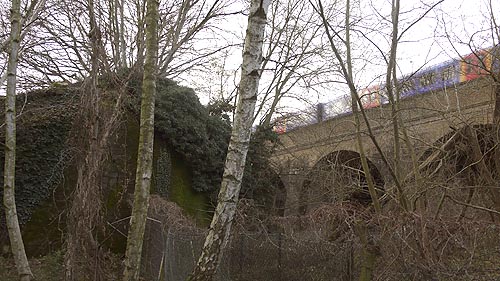
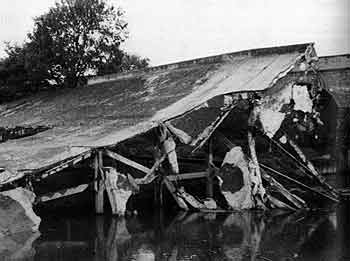
The bridge afforded a handy way to watch the racing for free. The river was a right of way and so anyone with a boat could happily spectate from the water. There are lots of photos like this, showing people often in rented punts having a nice cheap motorsport experience. Nowadays they'd put up a fence to stop the freeloaders seeing anything, but in fact the authorities were doing similar things to stop the fun at Le Mans in the '20s. Perhaps Brooklands was a bit more relaxed about a handful of non-paying (literal) punters...
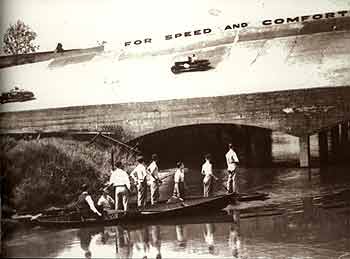
Back on the pavement, if you continue walking around the back of the Mercedes complex there is a section of original track with virtually no banking. This is owned by Mercedes and used for car parking, driving instruction for the under 17s and (currently) access to the M-B off-road course. Occasionally open to the rest of us for special events (I was last on it riding in John Seller's Fox at Military Vehcle Day) it's interesting for the incredible amount of marking to the surface. Lots is doubtless due to the ravages of time on 100 year old concrete but there are odd square shapes, filled in with tarmac, and other evidence of hole filling. I'd bet that some of these are evidence of the structures erected on the track during WW2. - Dummy houses and other disguises were erected to break up the distinctive outline, as well as other things supporting the main wartime function of the place as an aircraft factory.
The Byfleet banking
While in the museum complex, or behind M-B World you could be forgiven for
thinking that it is all that remains of the whole track site. No mention
is made of the area beyond the runway, right round the track to where Gallaghers
now stands.
In fact if you turn right out of the museum site and
head towards Byfleet and the Tesco and M&S superstores a revelation
awaits!
A huge swath of banked track survives, overlooking
the store car parks. Apart from a slice cut through to allow the road to
head off towards Weybridge, most of the original Byfleet Banking is still
there. While not as steeply raked as the Members' end, the Byfleet curve
is a much larger radius and allows a clearer view of long sections of track.
Covered in Moss and other plant life, and with largish bushes growing out
of the top, this section is very impressive, you can almost feel
the ghosts thundering by!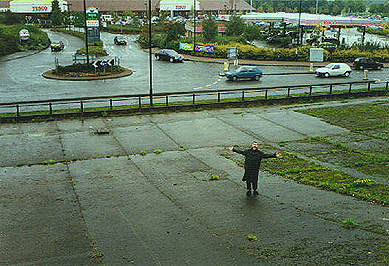
The piece opposite Tesco has no serious fencing to keep
people off so you can clamber about at will (though don't blame me if it turns out you shouldn't!). From the top you can
just see the top of the clubhouse in the distance, giving an idea of the
scale of the whole oval. It really is huge!
The section the other side of the gap is fenced
off, with a sign saying "private property" but giving no clue who owns
it. Is it the Museum?, the Council? or Tesco? who knows? Accessibilty here is equally unclear. with a gate in the fence which is sometimes unlocked and what appears to be a footpath along the foot of the bank. The rule of thumb I apply is: Gate locked - out of bounds. Gate open = go for it but be prepared to leave wwithout arguing if challenged. I've never seen a security guard here and all the businesses have substantial fences along the back. The implication of a fence is that you must be supposed to be on one side of it after all..
The banking here is quite flattened and strewn with a fair amount of rubbish, but it's possible to get a good idea of how the cars would have come off the long Railway Straight at high speed before the curve would slingshot them around the constant-radius bend. If the gate is locked, don't worry, there's another accesss point further round.
Walking along the road which is now on the outside of the track you come to a small rather forlorn house almost in the shadow of the banking. A JCB digger is currently flattening more of the site next to it, no doubt for some more executive shoeboxes, sorry "starter homes". This clearing work has revealed the footings of the old footbridge which used to provide pedestrian access at this end. (NB: these houses have now been built and access now isn't possible - private property!) Moving further down the road, past the Bentley Dealership there is an industrial estate on the right. The main road of this estate follows the foot of the earth bank behind the track. At one point there is a set of steps up this bank to a gate in the fence. This gate, which is also sometimes open allows shortcut access to the industrial units within the track. Even if it's locked you can peer over and see the banking from the end, from about the point where it starts to bank round off the Railway Straight.
The control tower
If you retrace your steps back past Tesco and round
the corner to Argos and Currys you will find another wonderful Brooklands
Building.
Now the offices of Naston Ltd. (a water
treatment engineering firm) the old airfield control tower
has been beautifully restored. It has a strange pavement which stretches
out across the lawn in front of it and has no discernible function. My best guess is an access path to a flagpole for a windsock.
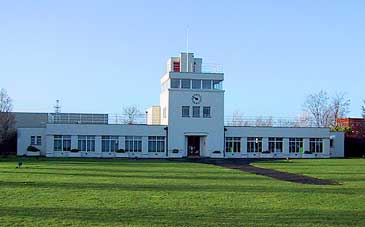 The
rear of the building is pure Art Deco with railings all round the
flat roofs to allow people to stand on them while watching aircraft. If
you walk on up the road and turn left at the roundabout you can reach
the other side of the locked gate. Head into the industrial estate within
the circuit you can reach the other side of the locked gate. It is past
the Tesco redistribution Centre, next to Kite Glass. A set of concrete
steps runs across the track and marks the effective limit of the remaining banking. The view from the steps looks like this:
The
rear of the building is pure Art Deco with railings all round the
flat roofs to allow people to stand on them while watching aircraft. If
you walk on up the road and turn left at the roundabout you can reach
the other side of the locked gate. Head into the industrial estate within
the circuit you can reach the other side of the locked gate. It is past
the Tesco redistribution Centre, next to Kite Glass. A set of concrete
steps runs across the track and marks the effective limit of the remaining banking. The view from the steps looks like this:
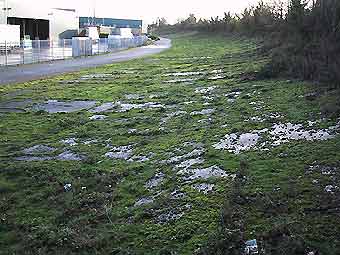 This
is roughly the start of the Byfleet Banking. The cut out section and the
fence are just out of sight round the bend. The Railway Straight, flat
and therefore built on was behind you. The tarmac section at the
left hand edge of the track peters out as well.
This
is roughly the start of the Byfleet Banking. The cut out section and the
fence are just out of sight round the bend. The Railway Straight, flat
and therefore built on was behind you. The tarmac section at the
left hand edge of the track peters out as well.
At this end, there are no fences or notices to prevent
pedestrian access, though there is a barrier to prevent cars from driving
on (!). I can't really see anyone stopping you walking along but remember
the notice at the other end- If you are done for trespassing don't blame
me! Remember also that the fence at the far end means you will have either
to climb it (not sensible!) or retrace your steps...
It is amazing really how much of Brooklands still survives. I know there are lots more bits still out there- Some of the smallest chunks of concrete are significant pieces of the history. What else is hiding out there? Every time I go, I have a bit of a poke round a different corner to see what else I can find, and add the results here.
Thanks to Andrew and Cath for photos and tip-offs on
where to find some of these things. P.R.
Other Features:
1. Le Mans Diary 2000 Five Go Mad at La Sarthe
2. Gentlemen and Cads The Terrible Turbo versus the Sublime Supercharger.
3. Hidden Brooklands. Poking around in the undergrowth.
4. The Mysteries of the Lucas Wiring System Explained. Well, you've got to have a system....
5. The Petrol head's Pilgrimage. USA Road Trip summer 2001
6. Brazilian Car Stereo. Choose your weapons.- Bob Marley at 50 Paces.
7. Restoring a Constellation. Never mind cars, Mike rebuilds airliners. - (admittedly not single-handed.)
8. Allan Winn - Breathing Life into Brooklands. Eoin Young interviews a fellow Kiwi
9. Son Of Mindless. The legends are true! A 4WD monster lurking in the Fens
10. Brooklands Double Twelve 2008. Event of the year.- Or how to compete against your own car..
11. Farewell to the QE2. Last voyage of a great liner